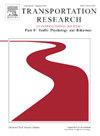Impact of the difficulty of the box task on its sensitivity when combined with a detection response task to assess secondary task demand while driving
IF 4.4
2区 工程技术
Q1 PSYCHOLOGY, APPLIED
Transportation Research Part F-Traffic Psychology and Behaviour
Pub Date : 2025-07-09
DOI:10.1016/j.trf.2025.06.028
引用次数: 0
Abstract
Multimodal in-vehicle infotainment systems offer drivers a range of non-driving-related functions but can increase visual-manual and cognitive task demand, compromising road safety. Therefore, it is important to estimate the secondary task demand of these systems early in the development process. To do so, the Box Task combined with a Detection Response Task (BT + DRT) was developed as a straightforward laboratory method. The BT is used to quantify the visual-manual task demand, while the DRT is capable of assessing cognitive demand. However, previous studies showed that difficult cognitive secondary task demand led to a similar decrease in performance in the BT to that found in the easy visual-manual demand. Therefore, this study aimed to enhance the BT’s sensitivity to visual-manual demand and discriminability from cognitive demand by increasing the difficulty of the BT. Additionally, the effects of increased BT difficulty on DRT metrics, self-assessed mental workload and secondary task performance were examined. In total, N = 39 participants performed the BT + DRT with varying BT difficulty levels (easy, moderate and difficult), secondary task types (visual-manual vs. cognitive) and secondary task difficulty levels (easy vs. difficult). The results indicated that lateral variability at moderate and difficult BT levels was the BT metric with the largest and most consistent effect sizes for assessing visual-manual secondary task demand and to discriminate from performance impairments resulting from cognitive task demand. At both BT levels, the DRT is also capable of effectively assessing cognitive demand, either through response time or the number of omissions. For self-assessed workload, only slight increases in ratings were observed for higher BT difficulty levels. There were only minor changes in secondary task performance, such as slightly slower responses, during more difficult BT levels. Consequently, a higher BT difficulty than previously used is recommended for the BT + DRT paradigm.
结合检测响应任务评估驾驶辅助任务需求时箱体任务难度对其灵敏度的影响
多模式车载信息娱乐系统为驾驶员提供了一系列与驾驶无关的功能,但可能增加视觉-手动和认知任务需求,从而影响道路安全。因此,在开发过程的早期评估这些系统的次要任务需求是很重要的。为了做到这一点,盒子任务结合检测响应任务(BT + DRT)被开发为一种简单的实验室方法。BT用于量化视觉-手动任务需求,DRT用于评估认知需求。然而,先前的研究表明,困难的认知次要任务需求导致的BT表现下降与简单的视觉-手动需求相似。因此,本研究旨在通过增加作业难度来提高作业对视觉-手动需求的敏感性和对认知需求的辨别能力,并考察作业难度增加对DRT指标、自评心理工作量和二次任务绩效的影响。总共有N = 39名参与者以不同的BT难度水平(简单、中等和困难)、次要任务类型(视觉-手动vs认知)和次要任务难度水平(简单vs困难)进行了BT + DRT。结果表明,在评估视觉-手动次要任务需求和区分认知任务需求导致的表现障碍方面,中等和困难水平的横向变异是最大和最一致的效应量。在这两个BT水平上,DRT还能够通过反应时间或遗漏次数有效地评估认知需求。对于自我评估的工作量,对于较高的BT难度水平,仅观察到评分略有增加。在难度更高的测试中,次要任务的表现只有轻微的变化,比如反应略慢。因此,对于BT + DRT范例,建议使用比以前更高的BT难度。
本文章由计算机程序翻译,如有差异,请以英文原文为准。
求助全文
约1分钟内获得全文
求助全文
来源期刊
CiteScore
7.60
自引率
14.60%
发文量
239
审稿时长
71 days
期刊介绍:
Transportation Research Part F: Traffic Psychology and Behaviour focuses on the behavioural and psychological aspects of traffic and transport. The aim of the journal is to enhance theory development, improve the quality of empirical studies and to stimulate the application of research findings in practice. TRF provides a focus and a means of communication for the considerable amount of research activities that are now being carried out in this field. The journal provides a forum for transportation researchers, psychologists, ergonomists, engineers and policy-makers with an interest in traffic and transport psychology.

 求助内容:
求助内容: 应助结果提醒方式:
应助结果提醒方式:


